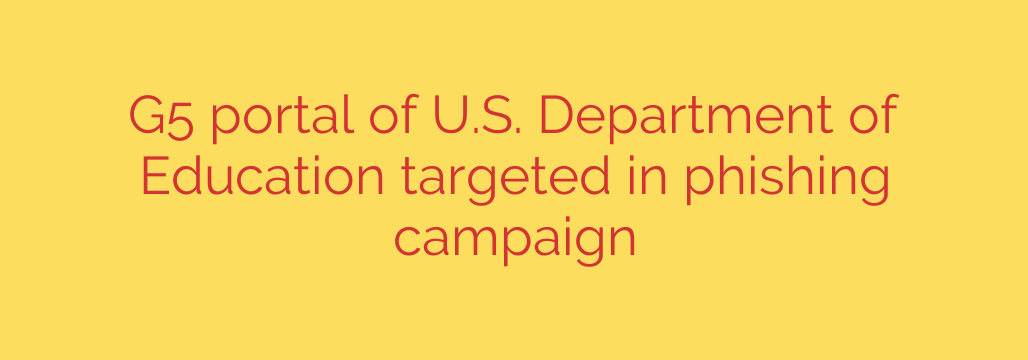
Urgent Security Alert: Phishing Scam Targets Department of Education G5 Portal Users
A sophisticated and dangerous phishing campaign is actively targeting users of the U.S. Department of Education’s G5 grants management system. This attack is designed to steal login credentials, giving cybercriminals access to sensitive financial and institutional data. All individuals and organizations that use the G5 portal for federal grants and payments must be on high alert.
The G5 system is a critical piece of infrastructure, handling billions of dollars in federal education grants. An attack on its users poses a significant threat to educational institutions nationwide.
How the Phishing Attack Works
Attackers are distributing deceptive emails that are carefully crafted to look like official communications from the Department of Education. These fraudulent messages often create a sense of urgency, warning users of a supposed security update, a pending account suspension, or a required verification step.
The core of the attack is a malicious link embedded within the email. When a user clicks this link, they are not taken to the real G5 website. Instead, they are redirected to a highly convincing, fraudulent replica of the G5 login page. This fake site looks nearly identical to the official portal.
Unsuspecting users who enter their username and password on this counterfeit page are inadvertently handing their credentials directly to the attackers. Once the criminals have this information, they can log into the real G5 system as the compromised user.
The High Stakes: What Attackers Can Do With Your G5 Credentials
The consequences of a compromised G5 account can be severe. With valid login credentials, attackers can gain unauthorized access to a wealth of sensitive information. The primary goals of this campaign appear to be financial fraud and data theft.
Once inside the system, a malicious actor could potentially:
- Divert federal grant payments to bank accounts they control.
- Access and steal sensitive personal and institutional financial information.
- Modify user details and contact information to further solidify their control.
- Commit widespread financial fraud using the institution’s identity.
Given the significant funds managed through the G5 portal, the financial and reputational damage from a successful attack could be catastrophic for an affected institution.
How to Protect Yourself and Your Institution: Actionable Security Tips
Vigilance is your best defense against these attacks. Follow these critical security practices to safeguard your G5 account and your organization’s financial well-being.
Never Click Links in Unsolicited Emails. The safest practice is to avoid clicking links in emails that ask you to log in or verify information, even if they appear legitimate. Always navigate directly to the official G5 website by typing
g5.govinto your browser’s address bar.Scrutinize the Sender’s Email Address. Attackers often use email addresses that look similar to official ones. Look for subtle misspellings or unusual domain names (e.g.,
dept.of.education-g5.cominstead of a.govaddress).Inspect Links Before Clicking. On a desktop computer, you can hover your mouse cursor over a link to see the actual web address it leads to. If the URL does not match the official
g5.govdomain, it is a phishing attempt.Enable Multi-Factor Authentication (MFA) if Available. MFA provides a crucial layer of security by requiring a second form of verification in addition to your password. This can prevent an attacker from accessing your account even if they have stolen your credentials.
Report Suspicious Emails. If you receive a suspected phishing email, do not reply, click any links, or download attachments. Report it to your institution’s IT or security department immediately.
If you suspect you may have already entered your credentials on a fake website, change your G5 password immediately and report the incident to both your internal security team and the Department of Education. Acting quickly can help mitigate potential damage.
Source: https://www.helpnetsecurity.com/2025/07/23/us-education-department-phishing-g5/








